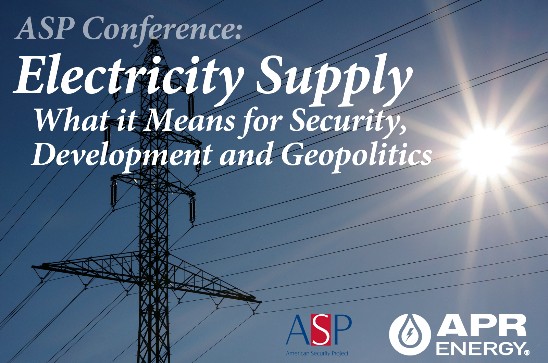 American Security Project
American Security Project
Innovative Solutions to Providing Reliable Power
Podcast: Play in new window | Download
Subscribe: Apple Podcasts | RSS
BGen Stephen A. Cheney, CEO of the American Security Project moderated the third panel discussion of “Electricity Supply: What it Means for Security, Development, and Geopolitics” on Innovative Solutions to Providing Reliable Power. The panelists were Eric Toumayan, Managing Director of Government Relations at APR Energy, and Ken Ditzel, Managing Director at FTI Consulting.
Building on the theme of interrelatedness of electricity and national security, Toumayan described how APR employs new ways of thinking to satisfy underserved electricity markets. In 2001, APR opened a 20 MW plant in 60 days, and he described the changes in a town in Sri Lanka over those two months.
“The fishermen were selling fish on the beach, a few fish at a time, no way to keep them fresh. A few months after we turned the power plant on, the fisherman were selling a day’s catch at a time on a bed of ice. They’d plugged in an ice machine. And yet later on in the process when the plant was running a restaurant had opened on the beach. So these are the kinds of transformative events that happen on a day-to-day basis once you can provide power to the underserved markets.”
Citing power delivered to Sengal in 2011, he described how APR implements fast-track solutions. In Senegal 2011, power outages lowered GDP growth by more than 1% by year. The situation could have triggered violence and rioting. 50 MW of electricity were delivered in 60 days.
The consumer provides a location, typically near a power plant, fuel, and connection to the grid. APR provides everything else, and the consumer pays for kilowatt hours.
“The fast track solutions… are based on the use of power modules,” Toumayan said. The modules used to generate electricity are jet engines in a truck. They are in shipping containers and can go wherever a truck can go. The jet engines can use both liquid and gas fuels; they are reliable, and are 20 times more powerful than a diesel generator of the same size. The turbines are sustainable, quiet, and clean.
With the mobile turbine technology, power can be delivered quickly, and it can be delivered in very large increments.
Ditzel spoke about natural gas price considerations. “Gas is going to be important for what technology you choose going forward.” He highlighted three interconnected objectives for delivering electricity: reliability, low cost, and sustainability.
Reliability is always number one. Historically, cost has been number two. It’s becoming more and more fact that sustainability and low cost are becoming equivalent in terms of second place, given EPA’s regulations.
On reliability, Ditzel brought up coal use. Because of EPA regulations, coal consumption is going down. “Coal is there as a diversity fuel source for a lot of generators, and now it’s being slowly taken away.” Solar and wind power are backup energy sources, but their intermittent nature affects prices. Nuclear power takes too long to develop, on the order of 10 years. Going forward, natural gas will fill that role.
“No matter which way you look at it, predicting gas prices has been challenging,” Ditzel said. He showed several graphs of the AEO gas price range vs. the historical cost of gas, and showed how predictive models fluctuated. He said that international drivers, like flat global GDP growth, global shale gas boom, or the restart of nuclear reactors by Japan or Germany could lower international LNG prices.
To mitigate forecasting bias and price uncertainty, infrastructure to deliver gas should be built. This would help remedy bottlenecks like what happened during the polar vortex. Also, gas purchasers could mitigate risk by creating medium to long-term purchasing contracts with producers. Other ways to mitigate risk include investing in energy efficiency and renewable energy sources.
Further Reading





